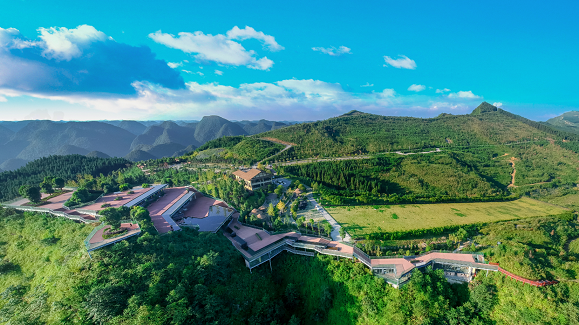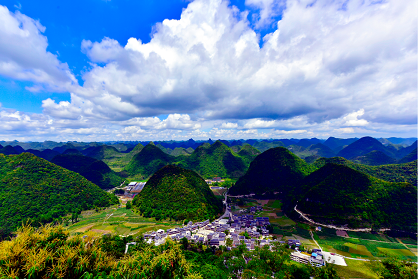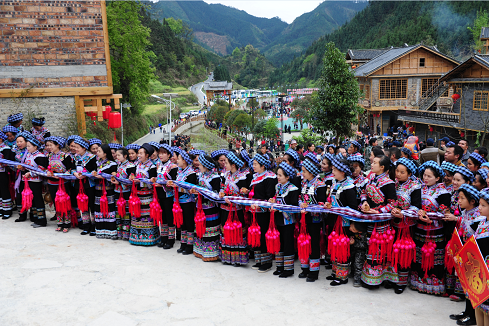- Profile Jurisdictions GOV DEPARTMENTS Cultures Travelling Educate
-
Ceheng County is located in the southwestern part of Guizhou Province, at the southeastern tip of the Qianxinan Buyi and Miao Autonomous Prefecture. It lies within the angle formed by the convergence of the Nanpanjiang and Beipanjiang rivers, two major tributaries of the upper Pearl River, between 105°27′ and 106°12′ east longitude and 24°38′ and 25°19′ north latitude. To the east, it borders Wangmo County across the North Panjiang River. To the south, it faces Tianlin, Leye, and Longlin counties of Guangxi Zhuang Autonomous Region across the South Panjiang River. To the west, it adjoins Anlong County, and to the north, it borders Zhenfeng County. The county spans a maximum distance of 73 kilometers from north to south and 76 kilometers from east to west, covering a total area of 2,598 square kilometers. The county seat is 120 kilometers from Xingyi City, the prefectural capital, and 330 kilometers from Guiyang, the provincial capital. The county's Party and government offices are located in Zhelou Subdistrict.

Natural resources are abundant. The highest elevation within the county reaches 1,634 meters, while the lowest is 375 meters, with an average elevation of 830 meters. As the county with the lowest latitude in Guizhou, it enjoys 1,492.3 hours of sunshine annually, an average annual temperature of 19.8°C, and total annual precipitation of 1,297.3 millimeters. With a frost-free period of 365 days, it is known as a “natural greenhouse,” providing ideal conditions for the growth of various crops. Mineral resources are abundant, primarily including gold, antimony, magnesium, and marble. Proven reserves include 23 tons of gold, 570,000 tons of antimony ore, 12.6 million tons of magnesium, and 1 billion cubic meters of marble. Total water resources amount to 1.841 billion cubic meters, with a total hydropower potential of 300,000 kilowatts. In recent years, leveraging its resource and ecological advantages while firmly upholding the dual bottom lines of development and ecology, the county has focused on forestry industries. It currently has 830,000 mu of Chinese fir, 350,000 mu of eucalyptus, and 2.83 million mu of forested land, achieving a forest coverage rate of 72.37%. Specialized industries including specialty forestry, vegetables, forest-grown mushrooms and medicinal herbs, and premium fruits now cover 907,300 mu. The county hosts 21 provincial and prefectural-level leading agricultural enterprises and 353 new agricultural business entities, with a total agricultural output value of 4.142 billion yuan. It has been honored with the titles “China's Glutinous Rice Banana Capital” and “China's Famous Camellia Oil County.”
Geographical advantages are increasingly evident. Located at the geometric center of a triangle formed by Guiyang, Kunming, and Nanning, Ceheng is approximately a 3-hour drive from each provincial capital and 90 minutes from Xingyi Airport. It serves as a vital transportation hub connecting Yunnan Province, southwest Guizhou, and coastal cities in Guangxi and Guangdong. The Nan-Kun Railway, Shantou-Kunming Expressway, and Wang'an Expressway traverse the county, while the Nanpanjiang and Hongshui River waterways are operational for navigation.

Ceheng County administers 3 subdistricts, 9 towns, and 1 township, comprising 33 neighborhood committees and 123 villages.
The administrative divisions (townships, subdistricts, and villages) of Ceheng County are as follows:
Zhelou Subdistrict administers Dongfeng Community, Gaofeng Village, Dongfeng Village, Zhelou Village, and Qianjin Community. The subdistrict office is located in Dongfeng Community.
Nafu Subdistrict administers Hongqi Village, Zhemeng Village, Yangqing Village, Ceyang Village, Fujin Community, and Fuda Community.
Gaolo Subdistrict administers Pingyang Village, Yangchang Village, Yangping Village, Gaozhai Village, Xishan Community, Banabu Community, Longjie Community, Zhelang Community, and Wenna Community.
Pomei Town administers Pomei Town Community, Hongqibao Community, Longdongwan Community, Bafan Village, Shuangxi Village, Dalu Village, Minzu Village, Tongxin Village, Natang Village, Nafu Village, Nali Village, Bada Village, Qingping Village, Chayuan Village, Zouma Village, Yanyun Village, Lianfeng Village, Zewang Village, Yangya Village, Sihé Village, and Weisha Village.
Rongdu Town administers Rongdu Town Community, Tianyi Community, Rongduo Community, Guanyin Village, Bayuan Village, Rongdu Village, Meijing Village, Maoping Village, Bannian Village, Bamou Village, Mannan Village, Rongbei Village, Tanping Village, Dazhai Village, Jiangjian Village, Weipang Village, and Tuangpo Village.
Qiaoma Town administers Qiaoma Town Community, Tuanjie Community, Ganyin Community, Fenjin Community, Xingfu Community, Kongtun Village, Guochang Village, Naxian Village, Natao Village, Zhegao Village, Banba Village, Weixian Village, and Qiaoma Village.
Yata Town administers Yata Town Community, Tiankan Village, Bawo Village, Yata Village, Bajin Village, Pingwei Village, Xingfu Village, Banqi Village, Banwan Village, Banjie Village, Luoshen Village, and Qiaodong Village.
Yangba Town administers Yangba Town Community, Yangba Forest Town Resettlement Area First Community, Yangba Forest Town Resettlement Area Second Community, Yangba Village, Banyong Village, Shunhan Village, Yangwang Village, Zhashu Village, Weibang Village, Yishao Village, Fuyao Village, Dawei Village, Bazao Village, Angtao Village.
Biyou Town administers Qiaoxiang Village, Yangxiang Village, Gelang Village, Luojiang Village, Weiwai Village, Yangli Village, Yangyou Village, Zheyu Village, Yangbing Village, and Biyou Village.
Baduzhen Town administers Weidong Village, Bada Village, Gannai Village, Naiyan Village, Tuangfeng Village, Xinhua Village, Zhanuo Village, and Baduzhen Village.
Yanjia Town administers Yanjia Town Community, Luowang Village, Luofan Village, Guabang Village, Luoda Village, Rongqing Village, Nongying Village, Huajiong Village, Nabeng Village, and Bannong Village.
Shuangjiang Town administers Shuangjiang Town Community, Pingwen Community, Bagao Community, Shuangjiang Village, Dingma Village, Luji Village, Bana Village, Linmu Village, Nayuan Village, Dingxiao Village, Dabing Village, Panjiang Village, Pinghua Village, Rongding Village, Luoyang Village, Ba Wang Village, Bamai Village, Babu Village, Qiaoba Village, Luofa Village, Yangrao Village, and Dapeng Village.

Baikou Township administers Dongli Village, Gejiang Village, Ba'ou Village, Nongding Village, Baikou Community, Baikang Community, Baisheng Community, Baoye Community, and Fushui Community.
Ceheng County traces its administrative origins to the Xia, Shang, and Zhou dynasties. It preserves diverse historical and cultural legacies including the ancient Luodian Kingdom ruins, former chieftain residences, ancient tomb clusters, rock relief carvings, totem worship, Buddhist-Taoist shamanism, and ritual music-dance traditions. After the founding of the People's Republic of China, the Ceheng County People's Government was established in 1951. It successively belonged to Xingren Special Administrative Region, Xingyi Prefecture, Qiannan Buyi and Miao Autonomous Prefecture, and Anshun Prefecture. In 1957, the State Council approved the relocation of the County People's Committee from Ceyang to Zhelou to build a new county seat. In 1958, Ceheng County was abolished and merged into Anlong County. In 1961, Ceheng County was reestablished. In 1965, the State Council approved the dissolution of Ceheng County and established Ceheng Buyi Autonomous County, which remained under Xingyi Prefecture. In 1981, Ceheng Buyi Autonomous County was transferred to Qianxinan Buyi and Miao Autonomous Prefecture. Concurrently, the autonomous county structure was dissolved and Ceheng County was reestablished.
contact details
Tel:00-86-0859-4211091
Address:No.43, Congjun Road, Jilou Street, Ceheng County, Qiuxi South Prefecture
Working hours:8:30 a.m. - 12:00 p.m. 2:30 p.m. - 6:00 p.m. (except legal holidays and public holidays)
